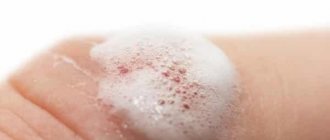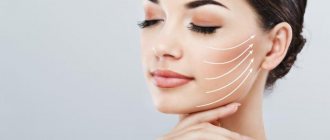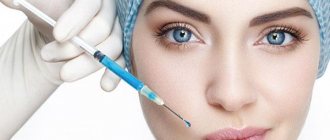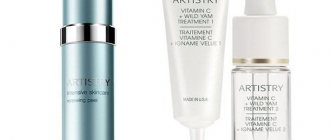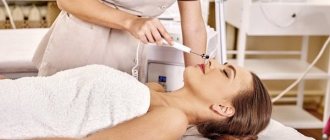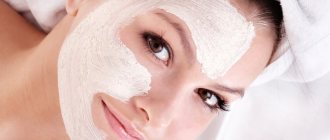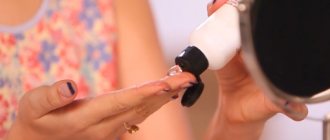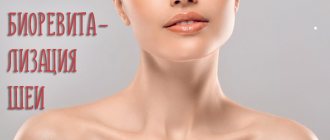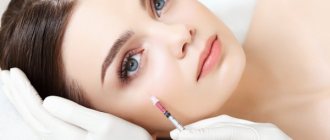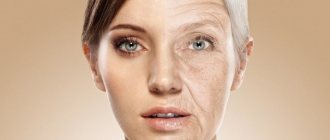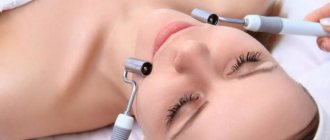The aging of skin cells can be stopped by turning to facial skin revitalization procedures.
This procedure appeared in Russian salons relatively recently and managed to win the favor of many women. We always try to look younger and more attractive. This is why the skin revitalization procedure was created. This is an injection technique for skin cell rejuvenation without a long recovery period. This procedure is performed on any problem area of the body. A procedure using hyaluronic acid is considered more common.
IN
With age, the production of hyaluronic acid slows down significantly. The skin on the face becomes dry. Expression wrinkles appear and skin color changes. Revitalizing the skin in a short period of time allows you to achieve colossal results. It improves appearance and prevents cell aging.
After the procedure, skin tone increases, facial wrinkles and nasolabial folds are smoothed, and complexion noticeably improves. More pronounced changes will be noticeable after several sessions, carried out several weeks apart. To consolidate the effect obtained, sessions are carried out once a season.
What explains the effectiveness of the method
Hyaluronic acid is produced naturally in the skin and plays an important role in maintaining its elasticity because it is able to retain water molecules. The substance works in conjunction with other elements - fibroblasts. Fibroblasts secrete proteins necessary for the formation of collagen and elastin and are responsible for tissue turgor.
Young, healthy skin on the face is the result of a combination of two factors: sufficient hydration and the amount of elastic fibers. With age, the work of fibroblasts slows down, and the concentration of hyaluronic acid decreases - the skin becomes flabby and loses its attractiveness.
The role of hyaluronic acid, which is administered during biorevitalization, is as follows:
- activates the activity of fibroblasts, promoting increased production of collagen and elastin;
- retains the required amount of moisture in cells;
- accelerates regeneration (formation of new cells).
In addition, after biorevitalization, the synthesis of your own hyaluronic acid increases. In this way, its deficiency is doubly compensated.
When is facial biorevitalization needed?
The procedure is justified in the age range of 25–50 years. The greatest effect of facial biorevitalization is noticeable in women in their young or early adulthood, 30+. The older you get, the more difficult it is to fully compensate for the lack of collagen and elastin; here you need to use other methods of skin rejuvenation.
The beauty of biorevitalization is that it can solve not only aging issues, but also many other skin problems.
Indications for biorevitalization:
- excessively dry skin from nature or from external factors (frost, sunlight, tobacco smoke);
- natural age-related changes in the face;
- the need to correct sagging eyelids, bags under the eyes, puffiness;
- pronounced pigmentation;
- enlarged pores;
- acne, blackheads;
- spider veins;
- recovery after plastic surgery, laser resurfacing, deep chemical peeling.
It is important to understand that biorevitalization will help to cope only with those problems the cause of which lies directly in the skin - for example, excessive activity of the sebaceous glands, dilated blood vessels, tissue injury. If acne appears due to hormonal disorders, and dull complexion is due to improper metabolism, then the procedure will not have the desired effect.
Indications and contraindications for the skin revitalization procedure
Indications for skin revitalization
Conventional cosmetics will not be able to cope with the first signs of aging; facial revitalization will help with this. This procedure is indicated for women who:
dehydrated and dry skin;- there is no former firmness and elasticity;
- there is sagging skin on the inner thighs, abdomen and arms;
- age-related changes are noticeable;
- uneven and pale complexion;
- age exceeds 35 years.
The revitalization procedure perfectly moisturizes the skin, evens out the surface and tone of the face, making the skin smoother and more elastic. Eliminates stretch marks, scars and age spots.
Contraindications
The facial skin revitalization procedure has a number of contraindications. Such as:
- skin diseases;
- deformation of the skin;
- acute infectious diseases;
- pregnancy and lactation;
- herpes formations;
- oncological diseases;
autoimmune diseases;- hypertension;
- individual intolerance to hyaluronic acid;
- poor blood clotting.
In these cases, you should consult your doctor before using the product.
Advantages of the method
After biorevitalization, the face looks fresh, the oval is corrected, small wrinkles disappear, and the tissue structure is restored. The main advantages of the method:
- cell renewal and slowing down of aging occur at a natural, “natural” level;
- the procedure does not require lengthy preparation,
- biorevitalization of the face takes less than an hour, there is almost no pain;
- recovery is also fast;
- the result can be enjoyed after 1–2 sessions;
- very few specific contraindications;
- long-term preservation of the effect with minimal intervention;
- low cost compared to other methods.
The only disadvantage we can note is that to achieve a long-term result, you need to go through the procedure several times, but the effect is worth it. Another nuance is that it is difficult to find a decent specialist, since the demand for biorevitalization attracts too many amateurs to the service market.
Reviews
Ekaterina, 39 years old: “This is not the first time I have given injections. The result of revitalization is noticeable literally after the second session.
The skin looks healthy, acquires elasticity and attractiveness. The before and after photos speak eloquently for themselves.”
Lina, 28 years old: “I have naturally dry skin that is prone to flaking. The complexion also leaves much to be desired. My cosmetologist suggested undergoing biorevitalization, and I agreed. After a course of 4 procedures, the skin was completely transformed - it became nourished and elastic, even a blush appeared. This was a real transformation for me, I’m very pleased with the result.”
In the modern world, probably every woman wants to remain always beautiful and young. Revitalization is a wonderful rejuvenation procedure, the benefits of which are appreciated by many people. If you regularly take courses of this cosmetic manipulation, you can delay skin aging for a long time, because it will receive all the necessary substances.
IA "MordovMedia". When using the material, a hyperlink is required.
Types of facial biorevitalization
Facial skin rejuvenation with hyaluronic acid is characterized by a simple procedure and minimal tissue trauma. And even then, we are talking about damage to the surface layers only when the drug is injected; in other cases, their integrity is preserved. Biorevitalization is divided into three types.
Injection
The most popular option. Hyaluronic acid is injected into the deep layers of the dermis using a syringe with a very thin needle. Typically, a pinpoint technique is used: many punctures are made at intervals of 1–1.5 cm. The method is a little traumatic; such biorevitalization is carried out under local anesthesia in two ways:
- Manual. The specialist injects the drug himself. The advantages include accuracy and care for tissues; the disadvantages include small errors in dosage and punctures.
- Hardware. Hyaluronic acid is injected with a special device. The method is more accurate, but the impact is more aggressive.
After injection biorevitalization, it will take 1-3 days to recover, then all the imperfections on the facial skin will go away on their own, and you can enjoy the effect.
Non-injection
Hyaluronic acid is delivered to the skin under the influence of physical forces, the surface of the tissue is not damaged. The method is considered gentle, the risk of complications is minimized. After the procedure, you can immediately go out into public.
The following types of impact are distinguished:
- cryobiorevitalization - “cold method”, liquid nitrogen is used;
- iontophoresis - galvanic current acts as a stimulator. An additional plus is increased skin tone, accelerated metabolism;
- ultraphonophoresis - hyaluronic acid penetrates the skin under the influence of ultrasound;
- magnetophoresis - magnetic waves are used;
- oxygen biorevitalization - active oxygen reacts with the injected drug and penetrates deep into the tissues.
Non-injection biorevitalization is chosen for patients who are afraid of facial injections, or for individual indications.
Laser
In fact, this is also a non-injection method, but it is distinguished separately because the laser has an additional effect on the condition of the skin:
- improves blood microcirculation, which increases the flow of nutrients and oxygen;
- additionally stimulates the production of collagen and elastin;
- eliminates inflammatory processes;
- corrects minor flaws - uneven microrelief, post-acne.
Laser biorevitalization uses low molecular weight hyaluronic acid, which better stimulates the activity of fibroblasts compared to high molecular weight. It reaches the cells to a depth of 4 mm and is distributed as evenly as possible.
This method of facial biorevitalization has a pronounced effect, has a minimum of contraindications (can be performed even on inflamed skin) and practically does not cause complications.
Injection biorevitalization of the face
Conventionally, we can distinguish three stages of facial biorevitalization: preparation, the process itself, consolidation of the result. You must first undergo an examination by a specialist to exclude contraindications:
- serious dermatological diseases;
- tendency to form keloid scars;
- cancer, autoimmune diseases, herpes infection.
The procedure is not performed during periods of exacerbation of general inflammatory and infectious diseases, during pregnancy and during breastfeeding.
Preparation
At the first consultation, the doctor talks with the patient and assesses the condition of the skin. He collects anamnesis, determines the affected areas, the appropriate drug and biorevitalization method to achieve the best effect. In most cases, tests are not required.
Progress of the procedure
There are no special recommendations on the appointed day. You should wear a cap and shoe covers.
The specialist’s action algorithm will be as follows:
- removing makeup;
- facial cleansing;
- antiseptic treatment;
- marking the coverage area;
- application of agents with an anesthetic effect (during injection biorevitalization) or an active drug with an active substance;
- manipulation of a syringe or device.
Facial biorevitalization is carried out from the 14th day of the cycle, that is, after menstruation, since before this day women have increased pain sensitivity and altered hormonal activity, which can reduce the effect of the procedure.
Consolidate the result
After the procedure, medicinal cosmetics are applied to the face, which has a calming effect. It also strengthens the effect of hyaluronic acid.
The doctor assesses the condition of the skin and gives recommendations for care in the subsequent period.
Biorevitalization takes 30–40 minutes. Includes preparation (5–10 minutes), waiting for the anesthetic to take effect (15–20 minutes). The chipping process lasts up to 20 minutes, laser treatment can take up to an hour depending on the time of exposure to each area.
What is revitalization?
This procedure was developed in the early 2000s, and represents an improvement in metabolic processes in the skin, complexion, and noticeable rejuvenation due to the introduction of certain substances into the dermis. The first revitalization techniques were based on injections. Later the use of laser was added.
Changes that occur with age lead to the formation of wrinkles, nasolabial folds and a deterioration in the general condition of the skin. The procedure allows you to improve your appearance in a short time. For effectiveness, cosmetologists recommend carrying out revitalization in courses of several sessions with breaks of 14-20 days.
Rejuvenation preparations may contain not only hyaluronic acid, but also peptides, amino acids and other substances. These components help smooth out wrinkles and improve skin condition.
For your information! The duration of the resulting effect lasts up to six months. After this, it is recommended to repeat the procedures.
The main advantages of this method of rejuvenation are:
- quickly obtaining good results;
- no recovery period;
- The effect lasts up to six months.
In addition to affecting the face and problem areas of the body, the procedure can be applied to the scalp. Hair revitalization is an effect on the skin in order to improve blood supply to the hair follicles. This procedure can accelerate hair growth and can prevent early baldness.
Techniques
The type of treatment is selected depending on the condition of the skin. If everything is clear with hardware biorevitalization, then, when considering the injection technique, we should dwell in more detail on the technique.
Papular technique
Hyaluronic acid is injected into the upper and middle layers, with the needle at an angle of 15 degrees to the skin. Papules form on the surface - small elevations filled with the active substance. They resolve within 3 days and the skin becomes even. Medium-sized papules, 3–4 mm, are made during rejuvenation of dense areas; papules with a diameter of 1-2 mm - when working with delicate areas of the face around the eyes or lips, 0.01-0.02 ml of the drug is injected.
Tubercular or micropapular technique
Injections are made at an angle of 45 degrees with a 4 mm needle, with its cut pointing downwards. The drug depot is created in the deeper layers of the dermis at a depth of 3 mm. Facial biorevitalization using this method is good because the skin after the procedure remains smooth, only traces of punctures are visible on it. But there is also a drawback - it is more difficult to control the volume of the injected substance and achieve uniform injection (papules in the previous method can be observed visually, so it is easier for a cosmetologist).
Linear-retrograde technique
The principle is borrowed from facial contouring, or rather reinforcement. This is a rather complex method of biorevitalization, which is why mesotherapists often neglect it. But it is also one of the most effective. To introduce hyaluronic acid, a needle 12–13 mm long is used. A puncture is made, then the needle is inserted parallel to the surface of the skin over its entire length, moving into the middle layers of the dermis. When moving backwards, the drug is released from the syringe.
The method allows you to reduce the number of injections. In addition, with deep penetration, tissues are more damaged, which stimulates more active regeneration and intensive production of collagen and elastin. Thus, biorevitalization achieves a double effect: due to the action of the active substance and due to the tissue response to irritation.
Advantages and disadvantages
When choosing a rejuvenation technology, you need to take into account the advantages and disadvantages of biorevitalization of the skin around the eyes.
Advantages of the procedure:
- safety when following injection technology;
- high efficiency of tissue self-healing;
- quick moisturizing effect on the skin;
- compatibility with other cosmetic procedures;
- short rehabilitation period.
Disadvantages of the procedure:
- presence of contraindications;
- the possibility of side effects and complications;
- exclusion from public life for 2–3 days;
- painful procedure;
- high cost.
Why is capillary mesotherapy needed?
The term means puncturing the vessels of the face and cervical-collar area in order to stimulate lymph outflow and improve blood microcirculation before biorevitalization. This reduces the swelling of subcutaneous fatty tissue and the volume of soft tissue, which ultimately enhances the effect of the rejuvenating procedure.
Capillary mesotherapy is desirable in the following cases:
- with severe swelling of the face;
- severe ptosis, that is, sagging skin;
- rosacea (transillumination of blood vessels);
- bright age-related changes after 45 years.
The injection is done with vascular preparations, starting from the cervical-collar area, gradually moving to the area of the earlobes, sternomastoid muscle, clavicles, and submandibular area. Then continue along the facial massage lines. For patients with dry skin and fine wrinkles, 1–2 procedures are sufficient. For deformational type of aging and over 45 years of age, 4–5 procedures will be required.
How long does the effect last?
Biorevitalization of the face gives a quick result, but how long it will last depends on heredity, the age of the woman, and the nature of the problems. On average, the procedure lasts 6–12 months. To achieve a lasting effect, it is recommended to repeat the manipulation several times. The quantity depends on the goals of biorevitalization:
- preventive - 1–2 procedures;
- therapeutic – from 5 sessions.
The interval is usually 2–4 weeks, more precisely determined by the doctor. Then, to maintain youthful skin, it is necessary to repeat facial biorevitalization every six months.
Preparation period
Facial biorevitalization involves several stages.
During the initial consultation, the cosmetologist collects anamnesis to determine the general state of health and makes recommendations.
Before the procedure it is prohibited:
- drinking alcohol;
- smoking;
- playing sports;
- therapy with drugs that can cause blood thinning (diclofenac, aspirin, various antibiotics, etc.);
- visiting a solarium;
- eating salty foods.
What you need to know about drugs
Hyaluronic acid in its natural form (unstabilized) remains in cells for 24–48 hours. If it is given a gel-like consistency, the acid will accumulate under the skin, and the life of the molecules will be significantly extended. Chemically stabilized hyaluron is destroyed more slowly, so the result of biorevitalization lasts longer.
There is also the concept of low molecular weight and high molecular weight hyaluronic acid. In the first case, it effectively stimulates the work of fibroblasts, which, as already mentioned, activate the synthesis of collagen and elastin. But since the latter have a short chain of molecules, they are unable to retain moisture in the cells in sufficient quantities. In the second case, on the contrary, hyaluron binds water molecules, providing good hydration and increasing skin elasticity.
There are also differences in the composition of the drugs:
- Monocomponent preparations (IAL-system, Juvederm Hydrate, Restylane Vital) are used for the age category of women 30–35 years old. Used to combat fine wrinkles and dry skin as a preventative against aging.
- Combined cocktails with hyaluron (Revofil Aquashine, Aquashine BTX) additionally contain minerals, vitamins, amino acids, coenzymes, and peptides with different properties. Biorevitalization of the face with these drugs is most effective when used as a course in women aged 35–45 years. The products can smooth out facial wrinkles, eliminate pigmentation, and fight skin photoaging and moderate age-related changes.
- Powerful biorevitalizants for aging skin (Meso-Wharton P199, Hyalrepair-02, NucleoSpire DNA-RNA). Nucleotides and growth factors are added to the above components. Such drugs can be used in women 35+ on an irregular basis, and at the age of 40–45 years - at each session. They give a visible effect and can solve most problems of mature skin: restore elasticity, remove wrinkles, lighten age spots, etc.
There are many companies producing drugs based on hyaluronic acid. The specialist selects the means for biorevitalization individually.
Complications and precautions
Side effects of biorevitalization occur rarely and can manifest themselves in the form of:
- allergic reaction to the drug or anesthesia;
- microhematomas, the nature and extent of which depend on the characteristics of the patient’s skin, the location of blood vessels and capillaries;
- infections due to non-compliance with asepsis rules or improper facial care.
Biorevitalization can also cause more serious complications: prolonged redness, the formation of nodules and other structures on the facial skin. In this case, you should consult a doctor.
Take the doctor’s recommendations seriously if you don’t want to get unpleasant consequences:
- do not touch your face for 24 hours after biorevitalization;
- do not use cosmetics for 2 days;
- postpone physical activity, trips to the bathhouse, solarium, beach for 2 weeks;
- do not drink alcohol at least for the first time;
- try to drink as much clean water as possible;
- wash with mild cleansers;
- treat your face with the prescribed antiseptic.
Proper care helps prolong the effect of biorevitalization.
Indications
With this anti-aging procedure it is possible to solve many problems:
- dry, dull or dehydrated skin;
- rosacea or pigmentation;
- facial wrinkles and skin creases;
- enlarged pores or impaired sebum production;
- post-acne;
- uneven facial relief;
- as a recovery after aggressive cosmetic procedures (peelings, microdermabrasion, laser resurfacing).
It should be remembered that if there are foci of inflammation or systemic diseases in the body, then the biorevitalization procedure may not have the desired effect.
How to choose a clinic
In order not to be disappointed in the results of biorevitalization, you should not turn to little-known private masters who do not bear any responsibility for the consequences and condition of your face.
The procedure must be carried out under strictly aseptic conditions by a specialist with a medical education who has permits and certificates. For a lasting result, the cosmetologist must choose the right medications and be proficient in the technique of biorevitalization. And this is impossible without knowledge of the basic physiological processes occurring in the skin.
The medical clinic employs cosmetologists with many years of experience. Before the manipulation, they will explain to you the essence of the procedure, tell you what the specialist will do, give answers to questions about the effects, and select the right technique. We are waiting for you at the address: Nizhny Novgorod, st. Studenaya, 57 every day from 8:00 to 20:00.
FAQ
This section contains answers to questions that patients most often ask.
Can I drink alcohol after the procedure?
No. Alcohol disrupts the water and acid-base balance, leading to dehydration and the development of edema due to poisoning by ethyl decomposition products. After procedures with hyaluronic acid, its consumption may lead to the development of side effects.
At what age can you do it?
After 25 years, the production of your own hyaluronic acid slows down. And the sun's rays accelerate its decay by 15-20%. Therefore, the recommended age of patients for biorevitalization is from 25 years.
Can I drink after the procedure?
Yes, clean water. Maintaining a drinking regime of 1.5-2 liters per day is recommended to speed up cell regeneration processes.
Is it possible to do it in summer
Can. The biorevitalization procedure does not depend on the time of year, but during the sunny period there are restrictions: the procedure is not performed on a fresh tan; After biorevitalization, you should use cosmetics with UV protection to avoid irritation on injured skin. In addition, ultraviolet radiation accelerates the breakdown of hyaluronic acid.
Is it possible to play sports
In the first week after the procedure, it is better to avoid training. Physical exercise increases blood circulation and can lead to the development of inflammatory processes in damaged skin.
How often can you do it
The recommended interval between procedures is 1 month.
How much does it hurt
Non-invasive methods do not cause discomfort. The injection method causes pain, like other injections with viscous drugs. For sensitive patients, the cosmetologist may use a local anesthetic.
